```
1. What makes Ginzan Onsen special today?
2. How can you get there smoothly from Tokyo or Sendai?
3. What are the best things to do and photograph?
4. Where should you eat and stay (with prices)?
5. When is the best season—especially February?
6. Summary and next steps
7. FAQ: access, budget, and booking
If you dream of a nostalgic hot-spring town set along a narrow river, Ginzan Onsen in Yamagata Japan is that picture. Wooden ryokan with creaking corridors line both banks; gas lamps glow at dusk; bridges tie the postcard together. The setting is small and human-scale, so you can slow down, stroll, and let the scene change with the light. In winter—especially February—snow stacks on eaves and handrails, turning the town into a silent stage for photos. In autumn, warm colors wrap the valley; in summer, trees green the river walk; in spring, meltwater feeds nearby falls. Getting in is straightforward: shinkansen to the local hub, then a short bus up the valley. Once you arrive, everything is walkable, and a traditional ryokan stay with seasonal kaiseki feels like time travel. This guide keeps numbers simple—Price/Time/Distance—and links you to Japanese official sources so you can book with confidence.
1. What makes Ginzan Onsen special today?
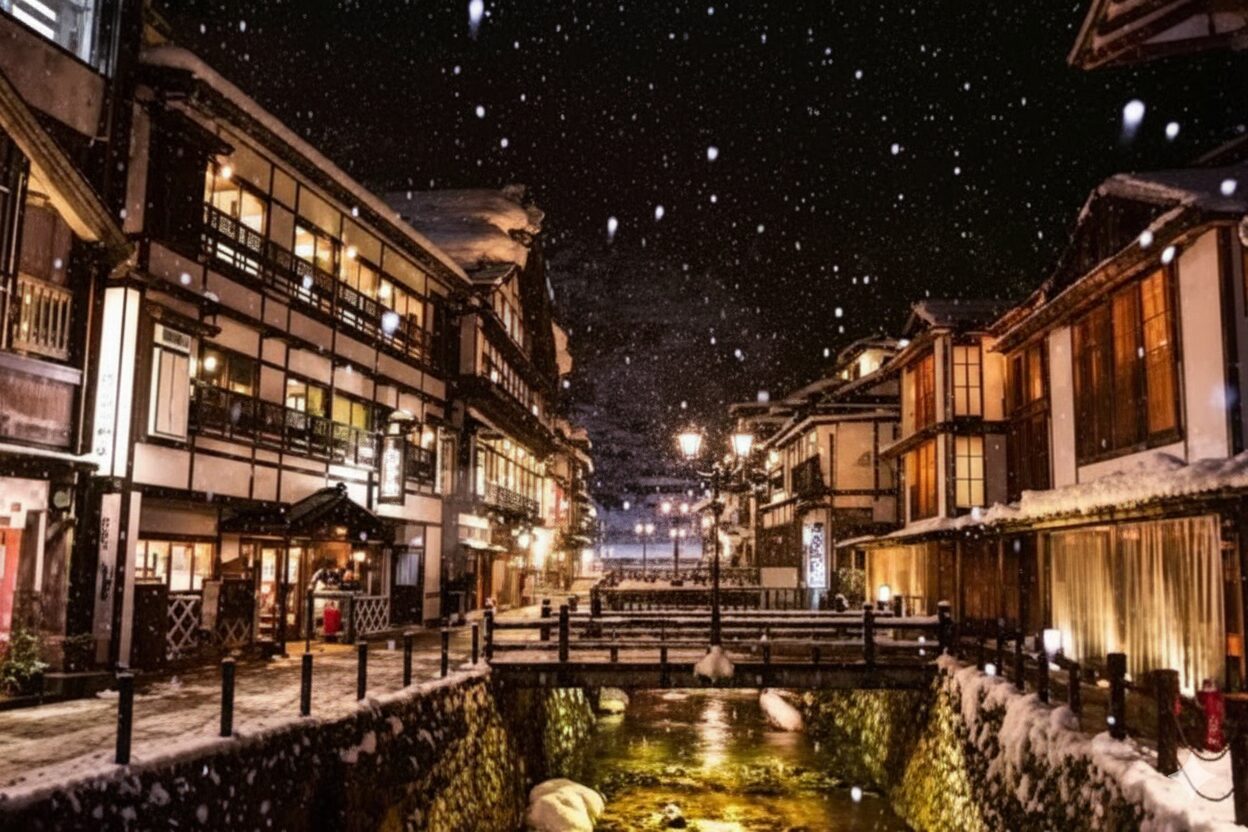
Ginzan Onsen sits in Obanazawa, Yamagata. The riverside core is short—roughly ~400–600 m end-to-end—so you’ll spend most of your time walking, photographing, soaking, and eating. The town’s name comes from a historic silver mine in the valley, now a hiking trail with tunnels and mossy stonework. For official overviews, see the prefecture’s tourism site (Official website (Japanese)) and the local association (Official website (Japanese)).
1-1 The look and feel at a glance
Latticework balconies, warm lanterns, and wooden façades define the streetscape. At dusk, gas lamps glow and reflections ripple in the river, peaking at blue hour. Winter adds snow texture; summer adds river sound and lush leaves.
1-2 When to slow down—and why overnight matters
Day-trippers arrive late morning; the street crowds midday. Overnight guests get quiet frames at sunrise and after dinner. An evening soak and an early walk are the best “filters” you can apply—no editing needed.
1-3 Etiquette and small-town respect
Keep tripods compact and off bridges in busy times; ask before shooting inside ryokan; no drones in the central area (common safety rule in onsen towns). Sidewalks are narrow—stand aside for luggage and delivery carts.
2. How can you get there smoothly from Tokyo or Sendai?
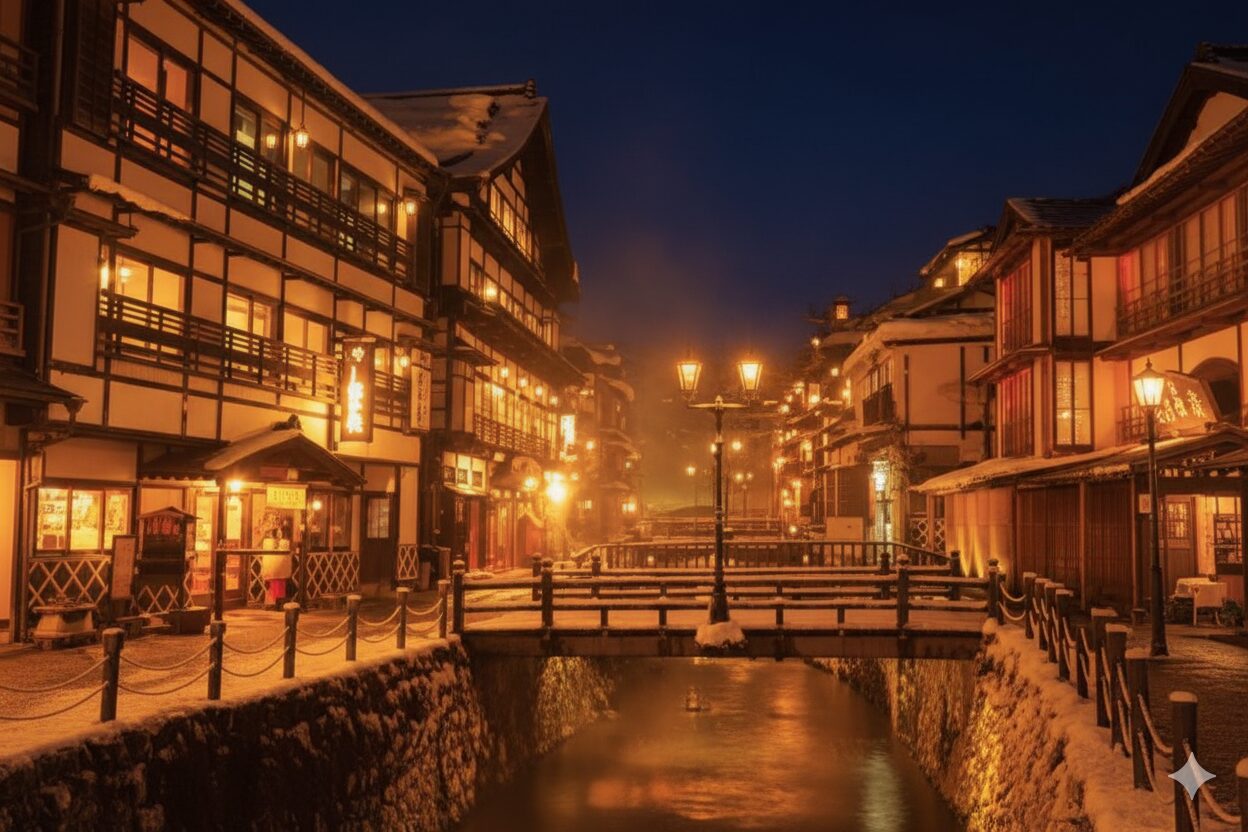
2-1 From Tokyo by train (Yamagata Shinkansen)
| Origin | Route | Time | Cost (one-way) | Official link |
|---|---|---|---|---|
| Tokyo | Yamagata Shinkansen → local bus to Ginzan Onsen | ~3 hr rail + ~40 min bus | ~¥12,000–¥15,000 (rail) + ~¥700–¥1,000 (bus) | Official website (Japanese) |
| Sendai | JR to local hub → bus | ~2–2.5 hr total | ~¥3,000–¥5,000 + bus | Official website (Japanese) |
| Yamagata Airport | Airport bus/taxi → rail → bus | ~2–3 hr total | ~¥2,000–¥7,000 (mix) | Official website (Japanese) |
* Times and fares are typical examples; check timetables and prices before travel. Sources: JR East and Yamagata Prefecture tourism.
JR network maps and service notices: Official website (Japanese). Prefecture access guidance (buses/roads): Official website (Japanese).
2-2 By air and by car (winter caution)
Flights arrive at Yamagata Airport; from there it’s rail/bus or a long taxi into the valley. Driving is possible but winter roads can be icy and parking in the core is limited to guests. Allow an extra ~30–60 minutes margin in snow.
Airport updates: Official website (Japanese). Road/caution info via the prefecture hub: Official website (Japanese).
2-3 Last-mile bus, walking distances, and luggage
The bus stop sits at the entrance of town; the iconic street begins right after. Walk the full loop in about ~30–40 minutes without stops. Riverbank paths are narrow—travel light and wheel suitcases slowly on bridges.
3. What are the best things to do and photograph?
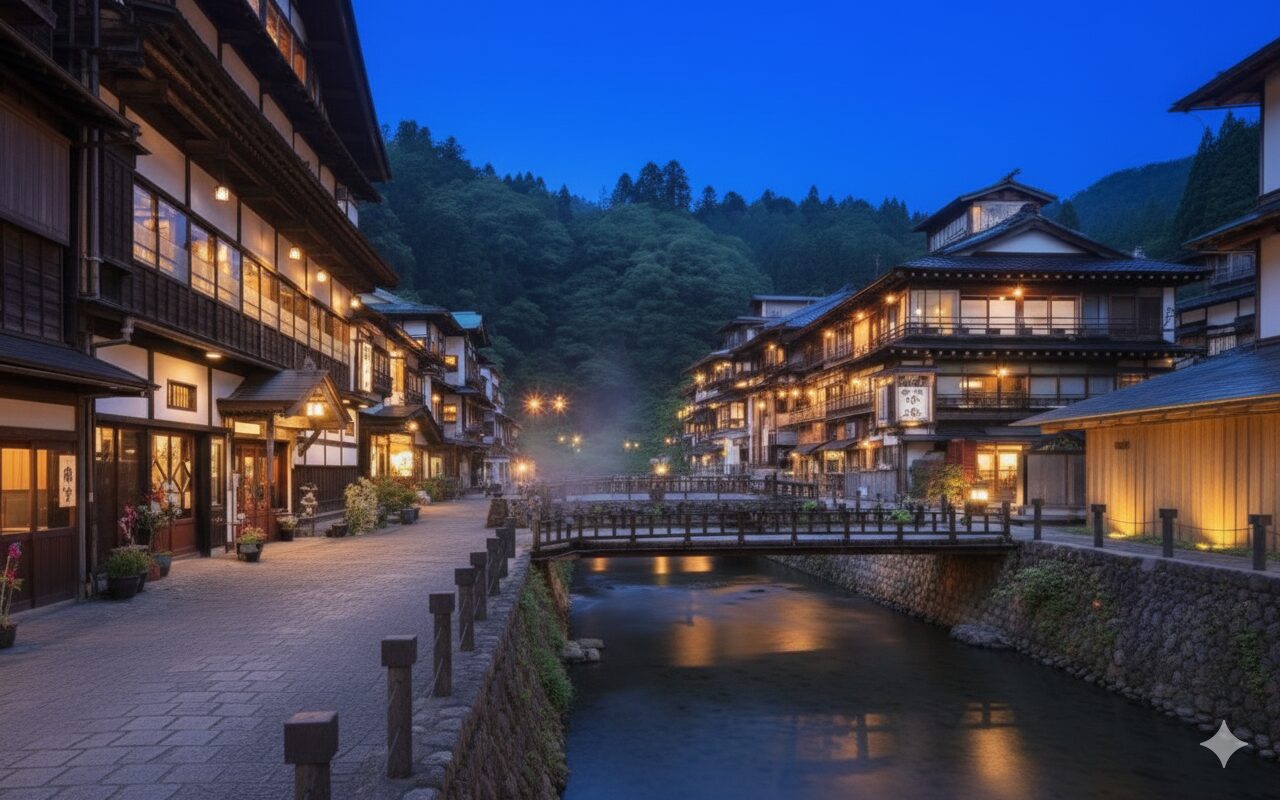
3-1 Retro streets, bridges, and gas lamps (blue hour)
Arrive before sunset to scout angles; the best frames are at blue hour when lamps are on and sky still glows. Handheld works fine at ~1/30–1/60 sec; keep tripods compact and off bridges when crowded. Town overview: Official website (Japanese).
3-2 Shirogane Falls and Nobesawa silver-mine trail
At the upstream end, Shirogane Falls drapes the rock face; farther into the valley the historic mine route offers short tunnels and mossy stone—allow ~60–90 minutes roundtrip for an easy stroll. Local info: Official website (Japanese).
3-3 Public bath, foot bath, and onsen etiquette
If you are not staying overnight, try the public bath (day use). Typical admission is ~¥500–¥700 and the soak takes ~30–45 minutes. Wash first, keep towels out of the water, and mind tattoos per facility rules. Basic etiquette: Official website (Japanese).
4. Where should you eat and stay (with prices)?
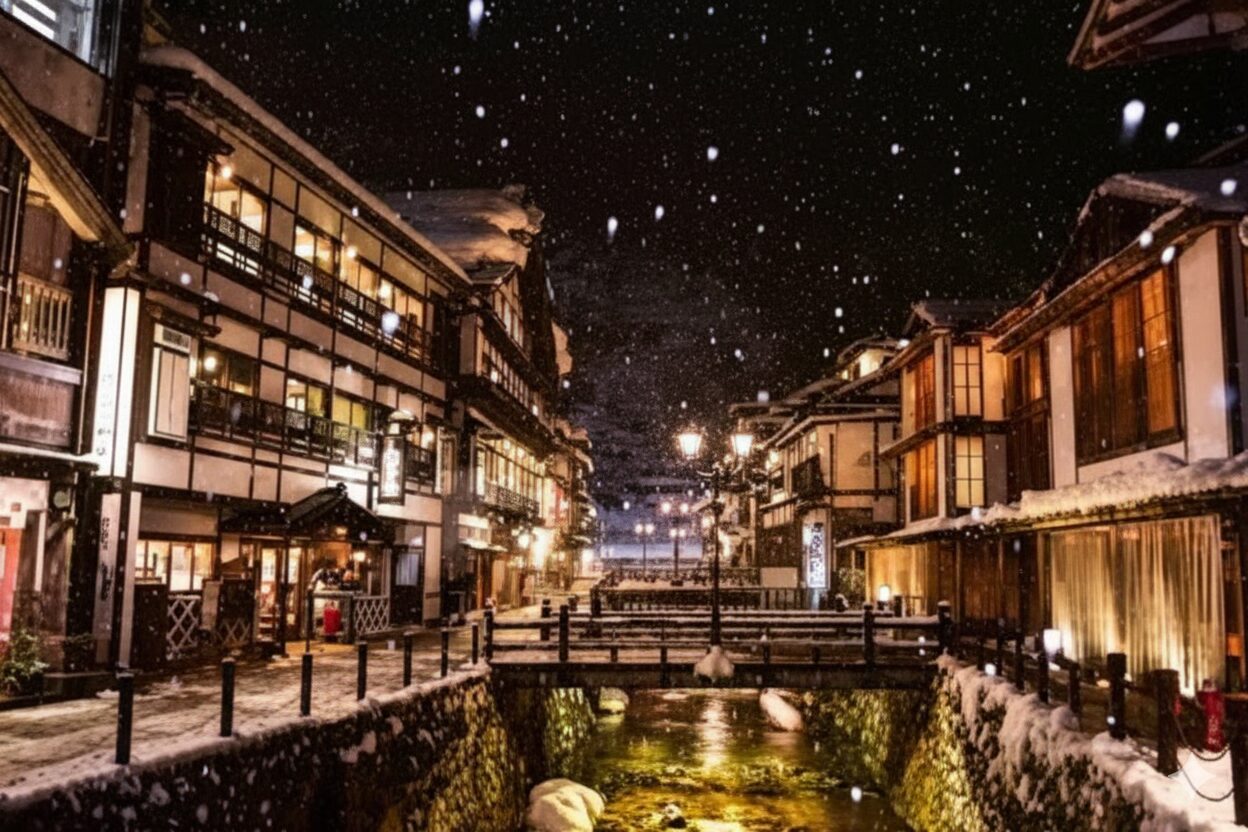
4-1 Choosing a ryokan (rooms, capacity, and style)
| Item | Price / Time | Notes & Official Link |
|---|---|---|
| Ryokan (pp/night, 2 meals) | ~¥20,000–¥50,000+ | Rates vary by date/room; book early for snow season. Ryokan list: Official website (Japanese) |
| Public bath day use | ~¥500–¥700 / ~30–45 min | Hours may vary by season; confirm locally. Etiquette: Official website (Japanese) |
| Café/soft-serve/snacks | ~¥500–¥1,500 | Riverside cafés open mid-morning to late afternoon. Area info: Official website (Japanese) |
| Taxi (hub → Ginzan Onsen) | ~30–40 min / ~¥6,000–¥9,000 | Winter adds time/cost; ask dispatch at station. Access notes: Official website (Japanese) |
* Prices are typical ranges; many ryokan use seasonal pricing. Always confirm on the official pages before booking.
Browse ryokan listings and booking contacts at the local association (Official website (Japanese)) and area summaries at the prefecture portal (Official website (Japanese)).
4-2 Day-trip dining (light lunches and sweets)
Expect light meals—noodles, curry, or rice bowls—and plenty of sweets/soft-serve. Lunch windows can be short; arrive before ~13:30 to avoid sold-out menus on busy days.
4-3 Booking tips (children, tattoos, and allergies)
Some ryokan limit small children in certain room types; ask about tattoo policies and food allergies at booking time. Many require prepayment or cancellation fees in peak season—read terms carefully on the ryokan’s own page.
5. When is the best season—especially February?
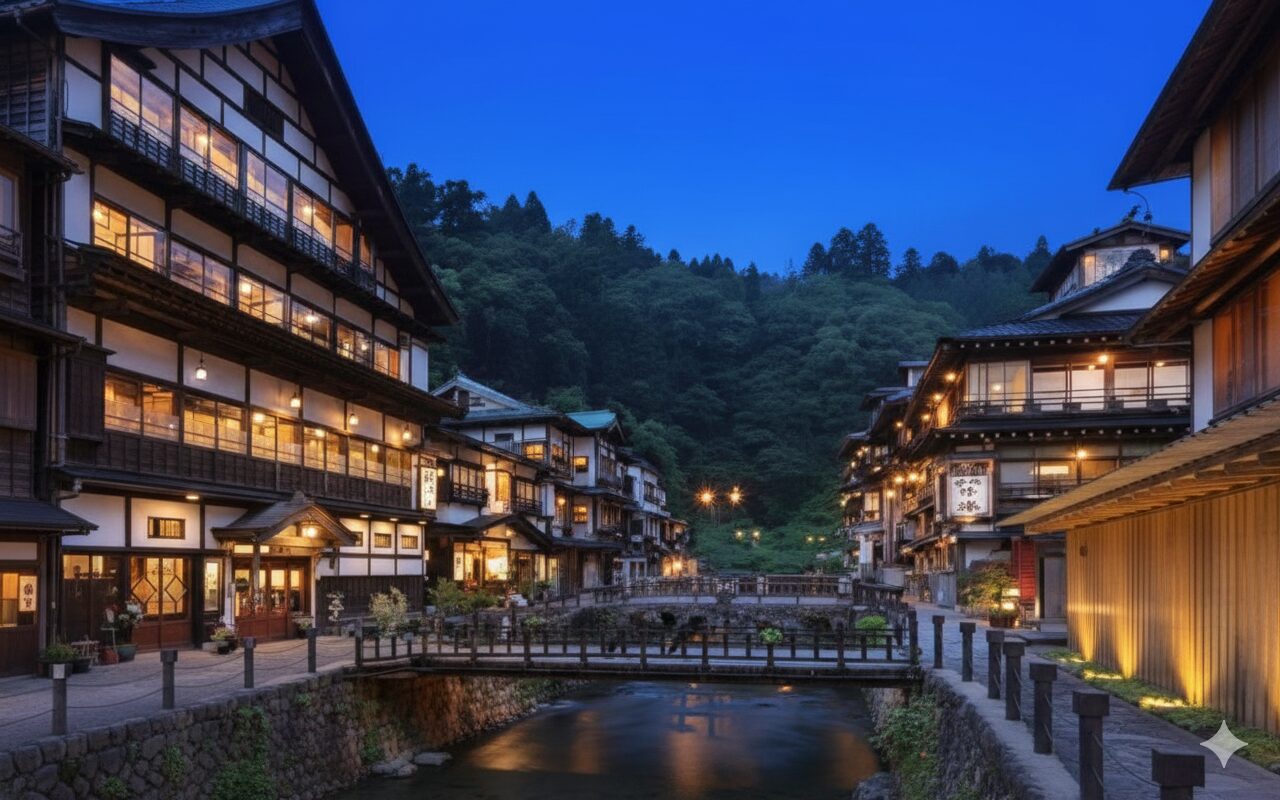
5-1 Winter magic: ginzan onsen february
| Months | Highlights | Crowd level | Official link |
|---|---|---|---|
| Jan–Feb | Deep snow, lamps + steam, blue-hour glow | High (weekends) | Official website (Japanese) |
| Mar–May | Thaw, quiet mornings, clear air | Low–Moderate | Official website (Japanese) |
| Jun–Aug | Green valley, river sound, evening walks | Moderate | Official website (Japanese) |
| Oct–Nov | Autumn colors and crisp air | Moderate–High | Official website (Japanese) |
* Winter conditions may affect roads and public transport—check the JMA and local transport advisories before travel.
Blue hour typically starts ~20–30 minutes after sunset; in winter this can be as early as ~16:30–17:00. Weather advisories and snowfall: Official website (Japanese).
5-2 Autumn colors and summer greens
Early November often brings peak foliage; summer adds soft light along the river and easy walking to the falls. Expect longer café hours in summer and shorter in winter.
5-3 Night light-up and crowd timing
The lamps switch on at dusk; arrive at least ~45 minutes early on weekends to secure a calm photo spot. Nighttime quiet hours apply—keep voices low and respect ryokan privacy.
6. Summary and next steps

6-1 One-page checklist
- Book ryokan (dinner/breakfast) and confirm tattoo/allergy policies.
- Reserve shinkansen seats in peak months; screenshot bus times.
- Pack boots and ice grips for winter; umbrellas are handy for drizzle.
- Arrive before dusk for scouting; plan a sunrise walk.
6-2 Useful phrases (simple)
- “Kassen arimasu ka?” – Do you take credit cards?
- “Kinyū shokuhin wa daijōbu desu ka?” – Is this safe for my allergy?
- “Keshōshitsu wa doko desu ka?” – Where is the restroom?
- “Kutsu o nuidemasu ka?” – Should I remove my shoes?
6-3 Plan and book
Use the prefectural portal for broad updates (Official website (Japanese)) and JR East for trains (Official website (Japanese)). Need help? Contact us for custom plans and reservations.
Contact Japan Travel – trip planning support
7. FAQ: access, budget, and booking
7-1 Is one day enough, or should I stay overnight?
You can see the core in ~2–4 hours, but an overnight stay adds quiet sunrise/blue-hour scenes and access to ryokan baths. Booking: Official website (Japanese).
7-2 How much should I budget?
Typical totals: transport from Tokyo ~¥12,000–¥15,000 one way; ryokan ~¥20,000–¥50,000+ pp/night with 2 meals; cafés ~¥500–¥1,500. Confirm on official pages (JR East / Prefecture).
7-3 When is the best time for photos?
January–February for snow (crowded weekends), Oct–Nov for foliage, and summer for greens. Check weather advisories at JMA: Official website (Japanese).
```